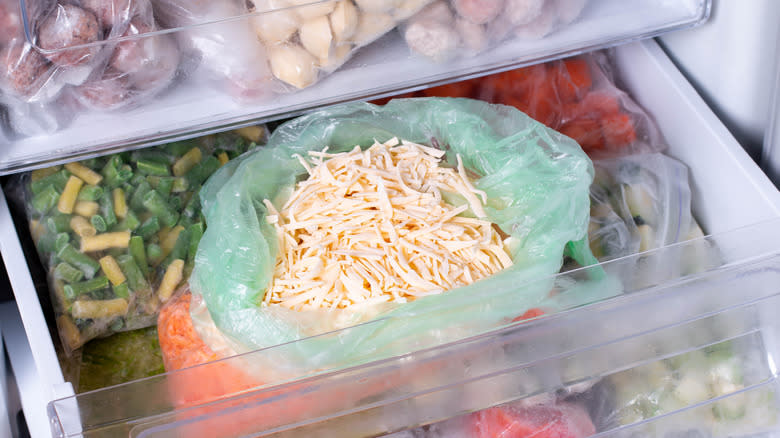What To Know Before You Freeze Cheese

When you find yourself in possession of a nice wheel or wedge of cheese, it's perfectly reasonable to wonder how you can extend its shelf life so you can enjoy it for longer. Freezing is a recommended method for preserving food for lengthy periods, but before you put that cheese in the freezer, know what type of cheese you have to determine its moisture content.
Every time a food item is placed in the freezer, its water content turns into ice crystals, causing its volume to expand by 9%. It contracts once it's thawed, however, and the changes in volume affect its molecular structure. Fresh, soft cheese like ricotta and Camembert have a high moisture content, and alterations in their texture turn them from creamy to crumbly. This also applies to variants with a low pH level, like cream cheese. The fat separates from the other components during storage, too, so the cheese turns out oily or grainy once it is thawed.
Semi-hard and hard cheese like gruyère, Parmesan, and cheddar do better when frozen. Processed cheese also fares well in the freezer because of the stabilizers added in by cheesemakers, and the pasteurization and standardization of the milk used contribute to its more freezer-stable qualities. Still, don't expect the cheese to retain its pre-frozen characteristics once it's thawed. Cheddar cheese, for example, won't slice as well as it used to. The flavor also stops developing during storage since freezing deactivates the enzymes and living cultures responsible for it.
Read more: What Happens If You Accidentally Eat Mold?
Consider How You Plan To Use The Cheese Later

Because of the quality changes it causes, knowing how you plan to consume the cheese later on can help you decide whether to freeze it or not. If it's for cooking purposes, go ahead and store your hard, semi-hard, and processed cheese in the freezer, ideally still in their unopened packaging. The change in texture won't be as noticeable when you melt it to whip up something like a three-cheese mushroom mac and cheese. Otherwise, unfrozen cheese is best when you plan to serve or eat it raw, such as when assembling a festive cheese board.
When saving leftover cheese, divide it into serving portions, then encase each piece in plastic wrap followed by aluminum foil to protect them from freezer burn before placing them inside a freezer bag. Aside from making it more convenient to defrost, slicing the cheese into smaller pieces also helps them freeze faster, which means the ice crystals that form will be smaller and less damaging to the food's structure and texture. For shredded or grated cheese, keep them in their original packaging if it has a resealable top. Release any excess in the air in the bag before sealing and putting it in the freezer so the cheese stays good for six months.
Thaw frozen cheese gradually so its moisture content gets redistributed evenly instead of creating soggy pockets. Place it, still wrapped, on a plate and let it defrost in the fridge for 12 hours.
Read the original article on Tasting Table.


